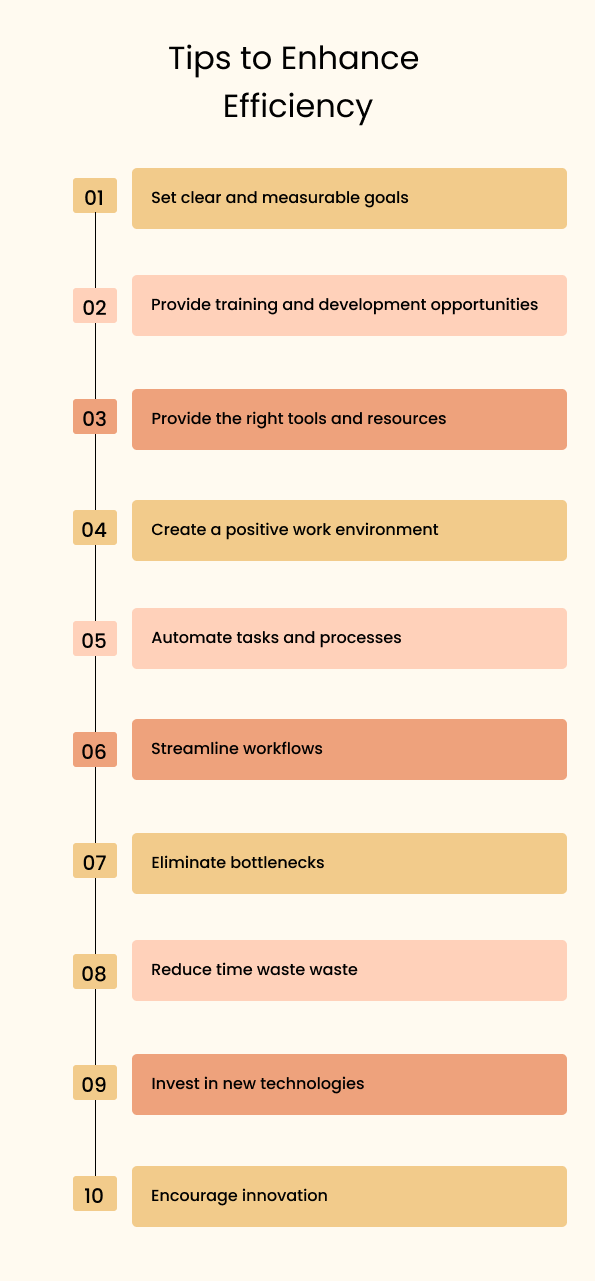
What is Employee Efficiency Rate: How to Calculate and Improve It?
Productivity versus Efficiency
The terms “productivity” and “efficiency” are often used interchangeably, but they represent distinct concepts that have a significant impact on your company’s success. Understanding the difference between the two can help you make better decisions and optimize your operations. So, let’s break it down.

Productivity: Doing More with What You Have
Productivity is all about output that is, how much you’re getting done in a given period. It’s the classic “quantity over quality” scenario. There are productivity tools that provide valuable insights into your work patterns, helping you maintain that delicate equilibrium between quantity and quality
The Formula = Productivity = Output / Input
For instance, consider a business or organization that provides a range of services to its clients. In a given month, the team delivers 500 completed projects. They dedicate 50 hours of labor and utilize various software tools and equipment to achieve these results. So, the productivity of the business would be calculated as follows:
Productivity = 500 projects / (50 hours + resources used)
Productivity = 500 projects / 50 units of input
Productivity = 10 projects per unit of input
In this example, the business is accomplishing approximately 10 projects for every unit of input, which includes both human effort and the resources employed.
The Catch: While high productivity may seem great, it’s not the whole story. Producing more doesn’t necessarily mean you’re making the best use of your resources.
Efficiency: Maximizing Your Resources
Efficiency, on the other hand, is all about getting the most out of what you put in. It’s “quality over quantity”. It’s like fine-tuning your instrument to create the perfect sound.
When we consider the context of the employee efficiency rate, it becomes even more evident how quality takes precedence. It’s about ensuring that the resources, time, and skills invested in a task result in a meaningful and valuable outcome.
The Win-Win Situation: Efficiency is like the sweet spot where you aim to maximize your output while minimizing waste, making the most effective use of your resources.
As you continue reading, we’ll explore how to calculate and improve efficiency. Stay tuned, as the journey to workplace optimization is just getting started! For now, let’s proceed by examining a comparison table between the two.
| Aspect | Productivity | Efficiency |
|---|---|---|
| Definition | The measure of output or work produced in a given time frame | The measure of getting the most out of what you put in |
| Focus | Emphasis on quantity | Emphasis on quality |
| Goal | Maximizing output in a given time frame or resources | Maximizing output with minimal input or resources |
| Impact on Business | Can boost revenue and market share but might lead to burnout or decreased quality. | Can reduce costs, improve quality, and customer satisfaction. |
| Examples | A software developer completing more code in a day | A call center minimizing call handling time |
Types of Employee Efficiencies in the Business World
“Static Efficiency” and “Dynamic Efficiency” are important concepts or types of employee efficiency in the business world. Here’s how they fit in:

Static Efficiency:
Static efficiency refers to the optimization of resource allocation at a given point in time. In the context of employees, static efficiency can be about making the best use of available resources, within the existing organizational structure. Efficient employees in this sense are those who can maximize productivity, and maintain a well-balanced resource allocation at a particular moment in time.

Dynamic Efficiency:
Dynamic efficiency, on the other hand, involves optimizing resource allocation over time, adapting to changes in the business environment, and ensuring long-term sustainability. Employees who exhibit dynamic efficiency are forward-thinking, capable of adjusting strategies and processes in response to market shifts, technological advancements, and evolving customer needs.
How to Calculate Employee Efficiency?
Needless to say, Efficiency is the lifeblood of any thriving organization. When your employees are working at their peak, your business flourishes. But how do you measure this elusive concept? The answer lies in the calculation of employee efficiency rate. There are 3 ways to calculate employee efficiency.
Productive Time Efficiency
Productive time efficiency is all about gauging the quality of time spent at work. To calculate it, you compare the total productive time to the total time an employee spends at work. The formula for this is as follows:
Productive Time Efficiency = (Total Productive Time / Total Time at Work) × 100
For example, let’s say Sarah’s total productive time in a day is 6 hours, and their total time at work is 8 hours.
Productive Time Efficiency= (6 hours / 8 hours) × 100 = 75%
This means the employee is operating at a 75% efficiency rate in terms of how they use their working hours.
Task Time Efficiency
Task time efficiency delves into how well an employee is using their time specifically for completing assigned tasks. This formula compares the total time spent on tasks to the total time at work.
Task Time Efficiency = (Total Time Spent on Tasks / Total Time at Work) × 100
For instance, if Sarah spends 5 hours working on assigned tasks during an 8-hour workday:
Task Time Efficiency= (5 hours / 8 hours) × 100 = 62.5%
This calculation reveals an efficiency rate of 62.5% for the employee in terms of task completion.
Task Assignment Efficiency
Task assignment efficiency focuses on whether employees are managing their assigned tasks within their designated time. This formula is constructed by dividing the total assigned time for tasks by the total time at work:
Task Assignment Efficiency = (Assigned Task Time / Total Time at Work) × 100
If Sarah is assigned 7 hours of tasks during an 8-hour workday:
Then, Task Assignment Efficiency = (7 hours / 8 hours) × 100 = 87.5%
This result signifies that the employee is operating at an 87.5% efficiency rate when it comes to completing their assigned tasks.
In all these calculations, a higher efficiency percentage is a cause for celebration. It indicates that a significant portion of an employee’s work time is used productively, with fewer distractions or unproductive activities.
Why Measuring Employee Efficiency is Vital for Your Business
One crucial aspect of this optimizing performance and productivity is measuring employee efficiency. By doing so, you can gain valuable insights into your workforce, identify areas for improvement, and enhance the overall effectiveness of your organization. So, why is measuring employee efficiency a necessity?

Performance Evaluation
Measuring employee efficiency is a fundamental tool for evaluating individual and team performance. It helps you assess how well your employees are utilizing their time and resources to complete their tasks. This evaluation can serve as a basis for recognizing high-performing individuals and identifying areas where additional training or support may be required.

Resource Allocation
Efficiency measurements can guide you in making informed decisions regarding resource allocation. By understanding which tasks or projects are consuming too much time or resources, you can relocate them to areas where they can be more productive. This, in turn, leads to cost savings and better utilization of your organization’s assets.

Goal Achievement
For your business to succeed, it’s crucial to set clear goals and targets. Measuring employee efficiency helps ensure that your employees are aligned with these objectives. It provides a tangible way to track progress and determine whether your team is moving in the right direction. In the absence of such measurements, you risk not achieving your business objectives effectively.

Identifying Bottlenecks
Efficiency measurements can uncover bottlenecks or inefficiencies in your processes. These bottlenecks can lead to delays and decreased productivity. By identifying and addressing them, you can streamline operations and improve workflow, ultimately saving time and resources.

Employee Engagement
Measuring employee efficiency benefits the employees too. When they see that their work is being evaluated,it can boost their engagement and motivation. Employees often take pride in their efficiency and strive to improve it, which leads to a more productive and satisfied workforce.

Continuous Improvement
Efficiency measurements are not static; they are part of an ongoing process of improvement. By regularly tracking efficiency metrics, you can implement continuous improvement strategies. This allows you to adapt to changing circumstances, adopt new technologies, and enhance the overall efficiency of your workforce.

Competitiveness
In today’s global marketplace, staying competitive is essential for the survival of your business. Measuring employee efficiency can help you stay ahead of the competition by identifying areas where you can outperform rivals, whether through quicker response times, superior customer service, or streamlined operations.

Tools for Measuring and Improving Employee Efficiency in Organizations
In today’s fast-paced business environment, the efficient use of resources, including employee time and productivity, is essential for success. To achieve this, organizations can utilize various tools and strategies that help measure and improve employee efficiency. One such tool is time tracking software. In this article, we’ll explore a range of tools

1. Time Tracking Software
Time tracking software is a fundamental tool for measuring employee efficiency. It allows employees to record the time they spend on various tasks and projects. The data collected can provide valuable insights into how time is allocated, helping identify inefficiencies and areas for improvement. Key features of time tracking software include:
Real-time tracking:
This software automatically tracks the time spent during work hours in real time.

Project and task categorization:
Time tracking software often allows users to categorize their work by project, task, or client, making it easy to understand where time is being allocated.

Reporting and analytics:
The software generates reports and analytics that offer a comprehensive view of time usage, highlighting productivity trends and areas that may need attention.

Identifying time sinks:
By analyzing the data collected, organizations can identify tasks that consume a disproportionate amount of time, allowing for better resource allocation.

Billing and client management:
For service-based businesses, time tracking software can aid in client billing by accurately documenting the time spent on projects.

Automated Timesheet:
keep accurate records of work hours and from clocking in to clocking out. Real-time timesheets allow you to focus on what matters most your work.

2. Project Tracking Tools
Project Tracking tools track, and collaborate on projects. These tools provide a centralized platform for assigning tasks, setting deadlines, and monitoring progress. By ensuring everyone is on the same page and tasks are well-organized, these tools improve task efficiency and completion times.

3. Communication and Collaboration Software
Effective communication and collaboration tools, such as Slack, Microsoft Teams, or Google Workspace, streamline communication within organizations. Timely and efficient information sharing reduces delays, minimizes misunderstandings, and fosters a more productive work environment.

4. Performance Management Software
Performance management tools allow organizations to assess employee performance, set goals, and provide constructive feedback. By setting clear expectations and offering opportunities for growth, these tools contribute to increased efficiency by aligning employees with organizational objectives.

5. Workforce Management Software
Workforce management software can be used to measure and improve efficiency. These tools provide data on computer usage, internet activity, and application usage. However, it’s essential to use them ethically and transparently, respecting employee privacy and consent.
Conclusion
Understanding and optimizing your employee efficiency rate is not just a matter of numbers; it’s a path to fostering a more productive and harmonious workplace. Remember, employee efficiency is about working smarter, not harder. It’s about creating an environment where your team can thrive and give their best while maintaining a healthy work-life balance. So, go ahead, calculate, improve, and empower your team to reach new heights of productivity!


This blog is a wake-up call for organizations to focus on enabling employee efficiency rate! Providing the right tools, fostering a supportive environment, and encouraging continuous improvement can unlock incredible potential. Let’s build workplaces where everyone thrives!